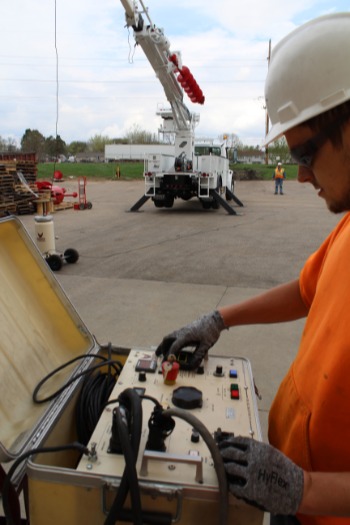Part 2 – Troubleshooting Tips When Insulated Booms Fail Dielectric Testing
In the previous article, we covered the different situations that occur when dielectric testing is needed and possible causes when the testing fails. The following steps will dig deeper on what can be done if the boom continues to fail.
After performing the initial troubleshooting steps needed when a boom fails dielectric testing – and it fails again - verify that the test equipment is working properly and set-up procedures are correctly followed before re-testing. If the unit still fails to pass the dielectric test, the problem must be identified by process of elimination.

Process of Elimination
Begin removing components inside of the boom one at a time and retesting. If a component inside the boom is identified as the cause of failure, then replace the component, refinish the boom with wax or silicone spray as specified in the unit specific maintenance manual, and perform the dielectric test again.
If all the components inside the boom have been removed and the unit still fails to pass the dielectric test, then there is a problem with the fiberglass boom. Use mirrors or a camera inside the boom to inspect for carbon tracking, embedded dirt or damage on the interior of the boom. Carbon tracking is a path that electricity uses to travel through the fiberglass. If rusty or dirty areas are found, then the interior needs to be scrubbed. If the carbon tracking has burned deep enough in the fiberglass it may require replacement.
After cleaning the inside of the fiberglass boom, re-test the fiberglass boom before replacing the components. If it passes the dielectric test, recoat the interior with silicone or wax to restore water protection. Then perform the dielectric test again after reassembly before returning the unit to service.
Check the Testing Equipment
If a thorough inspection and cleaning of the interior of the boom still does not result in passing the dielectric test, a DC dielectric test machine can be used to determine if the boom needs refinishing. Use 100-grit sandpaper to remove a 12-inch-wide area of paint and/or gel coat finish around the entire boom outer surface in the insulated section. Do not sand into the fiberglass. Clean and dry the boom and then perform the dielectric test again. Please note, that this only works for DC test equipment.
Replace the Boom
If the dielectric test fails, then the insulated boom must be replaced. If it passes, the outer coating must be removed, and restored by refinishing. Then coated with wax or silicone spray as specified in the maintenance manual. Perform the dielectric test again before reassembling and retesting before returning the unit to service.
Finally, if the boom must be replaced, a qualification test using AC test equipment must be performed to verify the specific insulating rating, before the unit can go back into service.
Terex Utilities Tech Tips provide additional insight into frequently asked questions that our service representatives receive. Tech Tips are a supplement to service manual instructions. The information in this article is taken from Tech Tip #51.

.png?sfvrsn=cfc0900d_0)